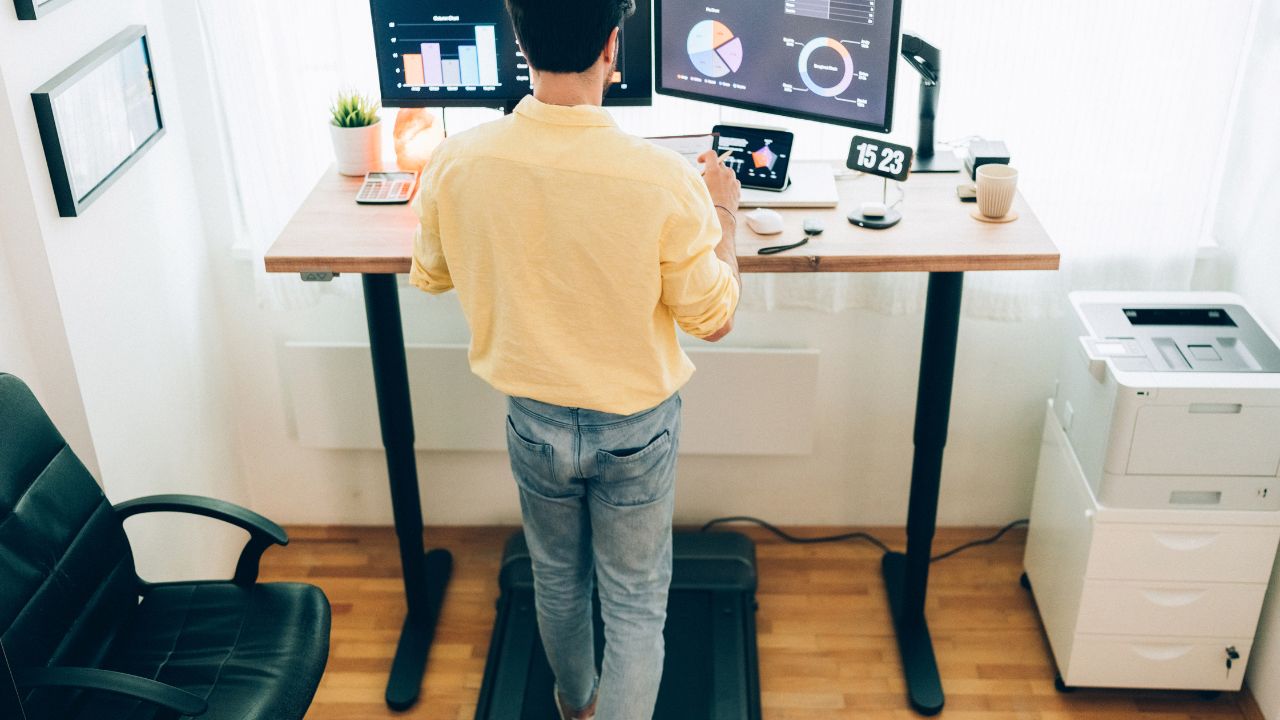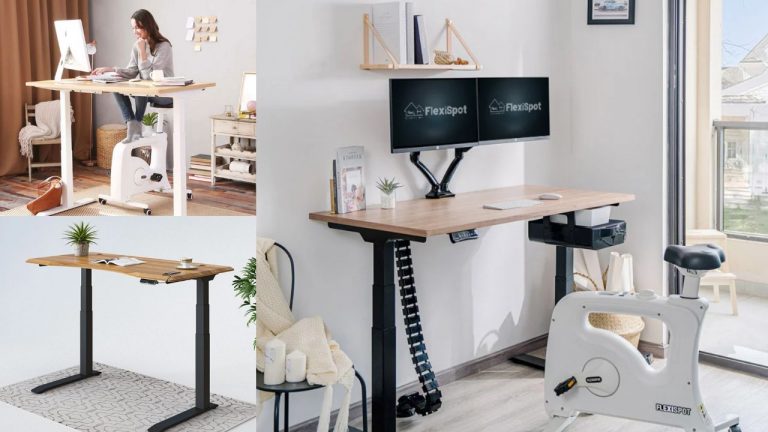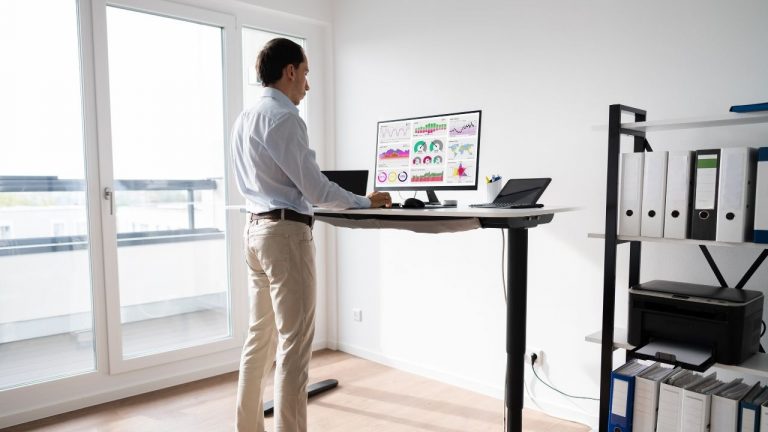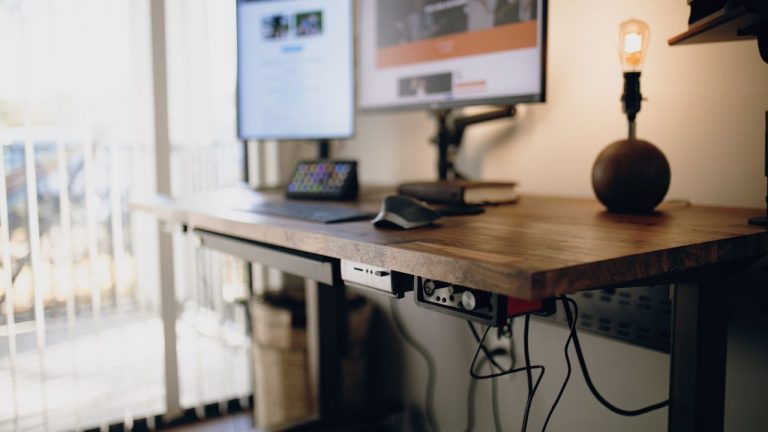How Often Should You Use Standing Desk?
You need a standing desk if you want to leave the old sedentary work life. But having a standing desk is not enough. You must know how to use it strategically to gain the most benefit. Before you decide on a routine, it’s wise to ask actually how often you should use a standing desk.
Stand for 10-15 minutes per hour to familiarize your body with standing desk. Depending on your muscle health, go from sitting to standing at least two to three times an hour. Walking a little in between surely helps.
There’s no rule of thumb when it comes to your body. If you feel pain, try to reduce the standing slot to your preference. And, for a detailed discussion, keep reading till the end.
Can You Use A Standing Desk Regularly?
If you own a standing desk, try to use it every single day. Our sedentary lifestyle usually doesn’t allow us to stand even for 2-3 hours per day. According to a study, an average desk worker spends 15 hours of his day sitting either at the office or at home chilling.
Needless to say, it’s horrible for our muscle health. In a recent study, it has been found that sitting all day can cause 30 chronic diseases after we cross the age of 30. The most common two diseases are type-2 diabetes and a weakened heart. Not just that, your chances of dying early increase by 49-50%.
That’s why it’s crucial for you to increase the time you stand or walk every day. Standing can only help you build this habit more easily. Since you approach the table every day, no matter what, for job purposes, you will slowly build a routine of standing for one to two hours every day. That’s not bad, considering you take other forms of exercise to keep your body fit and sound.
How Often Should You Use The Standing Desk Per Day?
You use the standing desk all throughout your working hour. But the question is, do you prefer the sitting position or the standing one? If you spend majority of the time sitting, it’s no less than a regular desk, no matter what its quality is.
So, “how often” actually indicates the number of minutes you spend standing in front of the desk or pushing the up arrows. The typical rule is to let the table stand at least two times per hour. You might ask, what’s wrong with keeping the desk at a standing height 24×7?
Well, you will be doing more harm than good. Your ultimate purpose is not to just stand for long hours. It’s to improve your body posture and blood circulation and reduce lower back pain. By standing too long without a break, you will give birth to another set of problems in your body. For example, interrupted blood flow into feet, pressure on hips and lower back discs, strained tendons, and so on.
And forget about a good posture. In no time, your body will go back to a hunched position like it used to. So, you have no choice but to move between sitting and standing throughout the shift. So if you want a number, try to raise the standing desk at least two times and let it stay for 5 to 10 minutes. Then, push the arrow button and sit again for some time.
Now, nobody can go from a sedentary lifestyle to an active one from the first day. There are three stages to fully adapt your body to this new workstyle. Check them out.

Stage-1
In the initial stage, you have to be careful about not burdening your body. Also, be prepared for a little discomfort. Your flex muscles have become weak due to years of sedentary behavior. It’ll take a little time to change that.
Divide one hour into two sections. Each unit has 30 minutes. Now, sit in front of the desk for the first 25 minutes and stand for the rest 5 minutes. Repeat the same process for the next 30 minutes.
There you go. You can now stand for 10 minutes within an hour. That means if you have a six-hour work shift, you are standing for one whole hour. That’s impressive as a beginner.
Stage-2
Continue the stage-1 method as long as you feel the muscles tightening when you stand. Once the leg and hip muscles move more freely, increase the length of your standing time. For example, divide one hour into 3 parts, each containing 20 minutes.
Like before, sit for 15 minutes and stand for the rest 5 minutes. Follow this for the next 20 minutes as well. That gives you 15 minutes of standing each hour. If your work shift is six hours, you will be standing for 1.30 hours easily.
Stage-3
It will take you months to reach stage-3. But don’t try to rush the process. Most people are not able to handle it if their muscles are not strong enough.
There are multiple ways to perform it. You can follow the 20-10 rule. That says, stand for 10 minutes every half an hour. And use the rest 20 minutes to sit and relax. That gives us 20 minutes of standing within one hour. You can reach your optimum daily standing goal by doing this.
If this doesn’t suit you, you can divide one hour into any number of segments you like.

What Is The 20-8-2 Rule? Does It Help?
The 20-8-2 rule suggests that you stay well-seated for the first 20 minutes. Then, stand up and stay in this position for 8 minutes. Try to maintain a straight posture. Then, give yourself 2 minutes to walk around the office. There you have covered 30 minutes. Do the same for your next 30 minutes.
This simple tactic is widely considered helpful for people suffering from lower back pain. You can’t stand for a long time (20 minutes) in one go. Plus, only sitting and standing back and forth might become too boring. Those two minutes of body movement will erase the fatigue from your body, leaving you fresh and productive.
If you suffer from the same issue, please give this method a chance.
How Can I Increase My Time In Front Of A Standing Desk?
Are you are still stuck at stage 1 after several months of using a standing desk? Then, you might need some help. Here are five tips you can follow.
1. Use An Anti-Fatigue Mat
Anti-fatigue mats significantly improve your experience with a standing desk. Usually, when we stand for quite some time, the feet get stiff due to the lack of blood flow. Soon it hurts to stay in this position any longer.
But an anti-fatigue mat allows our feet to move. You don’t feel any stiffness whatsoever.
2. Wear Comfy Slippers
Standing barefoot in front of a standing desk during work is a bad choice. The hard floor doesn’t help our feet in any way. In fact, the heel area gets stiff pretty early. If you are not into anti-fatigue mats, try to wear comfy slippers, at least. The slipper should be breathable so your feet don’t sweat excessively.
3. Eat Good
Eating well also helps with your body posture. Cut your sugar intake. It includes every type of carbonated beverage, food with icy sugar on top, etc. When your blood sugar is at an optimum level, you feel more active and can do a difficult task more comfortably. That includes standing as well. Go for veggies and meat to prepare the important meals of the day.

4. Take Stretching Breaks
Staying in one position for long hours can interfere with the blood flow in certain parts. It causes varicose veins to pop up and cause blood clots. To avoid this, take little stretching breaks. For example, you sit in a chair for 25 minutes. Take 5 minutes from this slot and do some yoga. Just bend or flex your body a little. It will make sure blood reaches every corner of the body.
Just a few more sessions, and you can see the improvement in your body posture in front of the desk.
5. Focus On Weight Loss
It’s applicable if you are considered overweight by a BMI calculator. Overweight people find it hard to stand for a long time. Your legs sometimes just give up. No matter what technique you apply, you will always have the urge to just sit down.
The only way you can escape this situation is by focusing on weight loss. You don’t have to follow a rigid routine. But try to live a healthier lifestyle and shed some pounds through exercise. You will definitely feel lighter and can stand for more minutes in front of the desk.
Before You Go…
Don’t forget the tips we have just given, especially the anti-fatigue mats. We believe it’s going to be a game changer in your journey with the standing desk. If you are not sure about the mats, check out our open discussion on whether anti-fatigue mats are worth the money or not. Have a look.



![Do Standing Desks Build Muscle? [Real Examples]](https://homethereby.com/wp-content/uploads/2022/02/How-Thick-Should-A-Standing-Desk-Top-Be-768x432.jpg)
![How Much Does VariDesk Cost? [Updated Price Chart]](https://homethereby.com/wp-content/uploads/2023/05/Varidesk-Standing-Desk-and-Desk-Converter-768x432.jpg)

